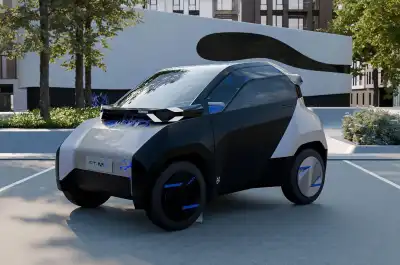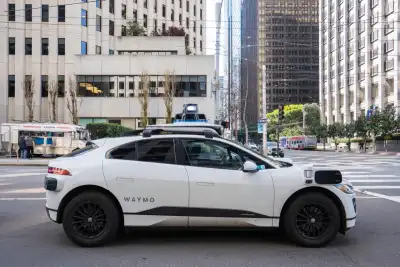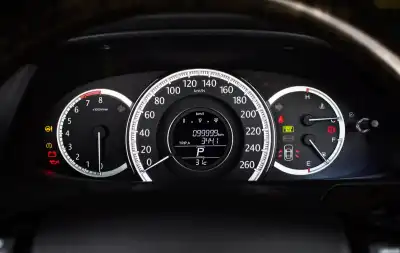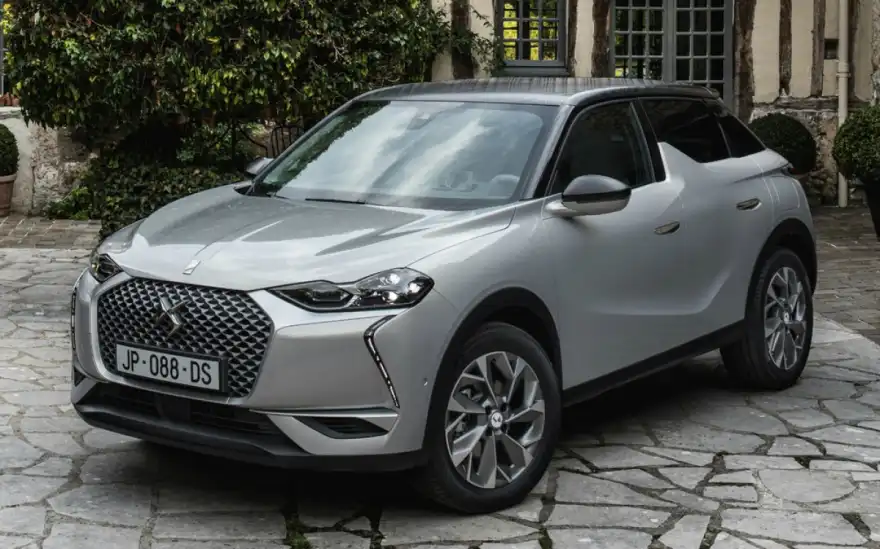
Tested: DS 3 Crossback E-Tense Ultra Prestige / Peugeot e-2008 GT Premium
Price: £38,600 / £38,580
DS Pros
Distinctive and appealing design
Strong value leasing and finance deals
Comfortable, soft suspension
Peugeot Pros
More space and practicality
High-tech interior
Impressive safety equipment
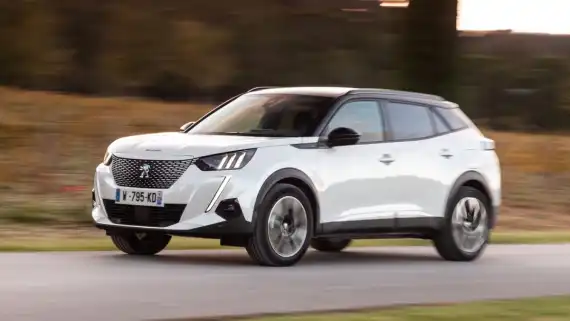
Introduction
You’d never tell at first glance, but the DS 3 Crossback and Peugeot 2008 are much the same cars, sharing the same chassis, suspension and engines. Both are clearly design-led models, full of dramatic style, but aimed at quite different customers.
The Peugeot is well known, with the compact SUV winning customers for several years. Now there’s an electric motor instead of a petrol engine, but everything else remains much the same. It’s based around the smaller 208 hatchback, but there’s enough about it - not least its styling - to paper over any cracks in its offering.
The DS is a rarer beast. The DS brand is the luxury arm of Stellantis, the parent company that owns, well, nearly every car company. Mechanically, it’s all but identical to the Peugeot, but brings with it bags of style and a distinctive luxury touch that you can only get from the French, but you do pay more for it. Ok, only £20, but still...
Performance
Electric cars usually provide instant acceleration that can be quite intoxicating, but this pair is rather more relaxed about how they get off the line. Sharing the same motor, there’s just 136hp available for speed, with 260Nm of torque to do the heavy lifting.
That should be enough for some solid performance, but it feels as if the cars are being held back, perhaps to extend the range of the batteries. The result is the cars hit 62mph from a standstill in 9.0 and 8.7 seconds, with the DS 3 being the quicker of the two.
Once rolling, they both carry on quite nicely, but only to a point. From 60mph or so, performance drops off and the cars feel lethargic; overtaking moves have to be carefully planned, as it takes more time to build up that last few miles per hour than you might hope for.
The modest performance levels should help you go further on a single charge, but neither model covered itself in glory. Officially, both will go as far as 206 miles before needing to find a plug and, as you might expect, the reality is a little short of that. However, the real frustration is the onboard computer’s estimated range calculator - it’s so far removed from reality that it’s next to useless, and could well leave you stranded. This is a common complaint across all of the Stellantis electric models, with one car overestimating by 56% in our tests.
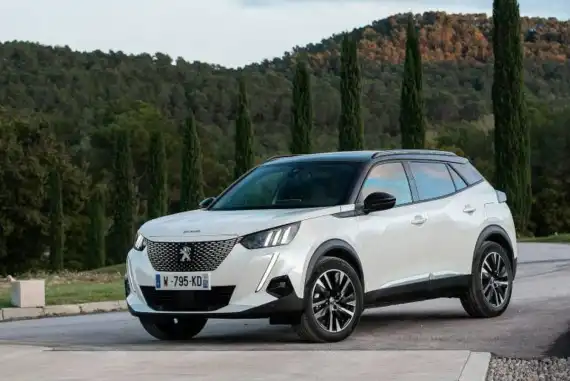
Ride & Handling
Neither of these models is destined to set lap records at the Nurburgring, but that’s good news for most buyers. Aimed squarely at those wanting a more comfortable and refined ride, both the e-2008 and DS 3 E-Tense are softly sprung and, for the most part, glide across UK roads.
Peugeot’s set-up is a nice compromise between the need for firm suspension for greater agility and the demand for something softer to create a cosseting environment. It’s judged well, although the car can float over crests in the road, and then struggle to control the resulting compression on the other side. It’s a small thing though, and only likely to be noted when traversing faster country roads. Through town it’s perfectly capable, squishing its way over bumps and cracks without a problem, while motorway work is smooth and refined.
Much of the DS 3’s behaviour is similar to the Peugeot model, but with everything amplified a little. To back up the luxury promises made, DS has softened the 3 to create a more serene experience. In urban areas (arguably its natural habitat) it all works well, with the E-Tense wafting over speed bumps and potholes with aplomb. However, find a faster highway and it becomes less precise, with increased body roll and a tendency to see the rear end bouncing from bump to bump. A billiard-table smooth motorway brings out the best of the DS 3 once again, though.
Refinement
A near-silent electric motor ensures that both models are pretty quiet on the road, although that exacerbates any wind noise at speed. Still, there’s no more than you’ll find in other cars, and there’s no engine drone to add to the mix on these. There’s not much in it, but the Peugeot feels like it's the quietest of the pair, although you’ll never describe the DS 3 as noisy.
With no gearbox as such, there’s no driveline shunt as the car lurches forward, making progress smooth and serene. There’s also little in the way of vibrations - again, as there’s no engine - which means the cabin in both cars stays calm and relaxed.
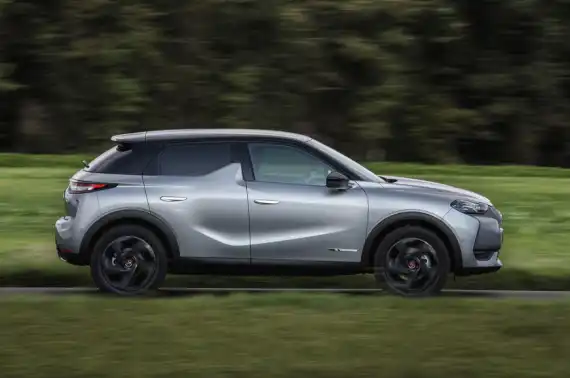
Behind the Wheel
Where the two cars differ is in the cabin, with one car providing a modern, technical design while the other follows a more avant-garde path.
It’s the Peugeot that’s more traditional in style, although its tiny steering wheel that sits below a digital instrument panel adds a certain flair that you won’t find anywhere else. It works too, at least for most people, with the small steering wheel creating a sense of space in the cabin.
In contrast, the DS 3 takes the diamond pattern from the front of the car and shoehorns it into every possible situation. Air vents? Diamonds. Engine start button? Diamond-shaped. Heating and ventilation controls? You guessed it. It looks magnificent and, when combined with the premium leather or Alcantara trim you can specify, creates a hugely premium sensation. It’s not without its flaws though, as the buttons below the infotainment screen are touch-sensitive, leading you to choose options with your palm as you try to adjust something on the screen.
Beyond the cosmetics, both cars are, again, broadly similar. They share the same infotainment centre and driver’s instrument panel, albeit with slightly different graphics on each, so you’ll be comfortable moving from one to another. There’s a high level of equipment fitted to both, with navigation, climate control, DAB radio and both Apple CarPlay and Android Auto fitted.
First impressions still count, and the DS 3 is the one any first-time passengers will be talking about. Even after a while behind the wheel, now and then you’ll glance around the cabin and catch a new detail that pleases. It’s the Peugeot that is the easiest to live with though and has enough of its own design touches to keep everyone interested.
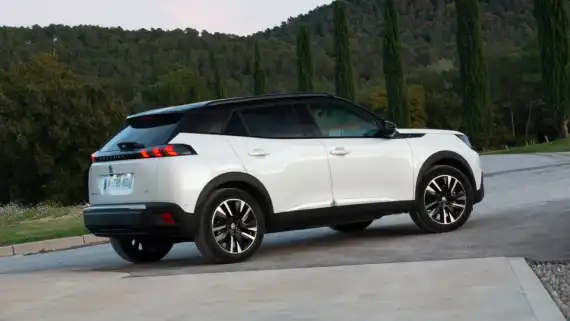
Space & Practicality
Despite sharing the same underpinnings, the e-2008 is quite a bit larger than the E-Tense. The DS measures 4,118mm in length, with the Peugeot measuring just over 18cm longer, at 4,300mm. More importantly, the Peugeot has 5cm more in the wheelbase and a longer overhang for the boot at the rear.
The result is that the Peugeot dominates the DS 3 in every area. Both cars have enough space in the front for two adults, with plenty of headroom and enough elbow room. Move back and the rear seats of the e-2008 will just about accommodate a pair of six-footers. Those in the back of the DS 3 don’t fare so well where, once they’ve folded themselves through the narrow door, will find that legroom is very tight.
The boot at the back of the Peugeot can accommodate 434 litres of cargo, which is more than enough for a weekend away with the family, or a holiday for two. The DS is tighter, at 350 litres and, to make matters worse, there’s nowhere to hide the charging cable, making it less suitable for family transport.
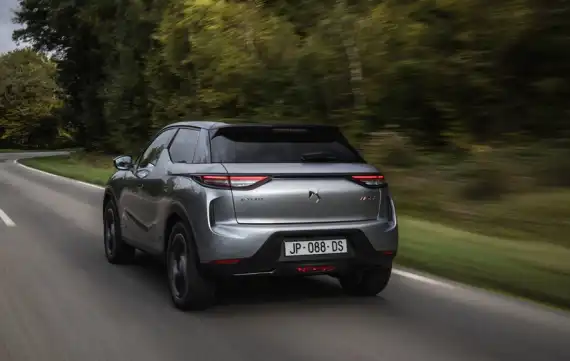
Running Costs
Sharing so much, there’s not much difference in running costs between these two models. They both promise up to 206 miles of range, and both deliver a little less than that in the real world, but there won’t be much difference.
Charge the car at home and you’ll be looking at around 5p per mile in electricity costs for either car. Of course, drive gently and stick to urban roads and you’ll be able to do much better than that. Likewise, do nothing but plough the motorways at high speed and you’ll get through more power.
Both cars are covered by a three-year warranty, limited to 60,000 miles, with the battery pack gaining extra cover - these are warranted for eight years or 100,00 miles, providing confidence for long term users or second-hand buyers.
Purchase costs are also similar with just £20 separating the two cars. However, when it comes to leasing deals, which is an option many are taking now, the DS has a significant advantage; a typical three-year deal could end up being around £100 a month cheaper than the e-2008, which could be enough to compensate for any of its shortcomings.
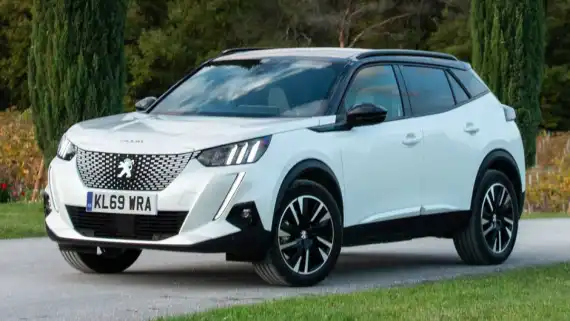
Quality & Reliability
There are parts of both cars that feel reassuringly solid, with a quality heft to switches and panels that you might not expect. However, there are also areas of both cars that feel rather flimsy and substandard but, overall, there’s nothing to be too excited about or too worried about.
Peugeot doesn’t tend to perform too well in reliability surveys, with the latest What Car? survey placing the company 25th out of 31 brands. While DS is too small a brand to get any meaningful figures, sister brand Citroen did rather better, placing 16th.
However, electric cars tend to perform better, so the e-2008 and E-Tense models should outperform the average for the manufacturers.
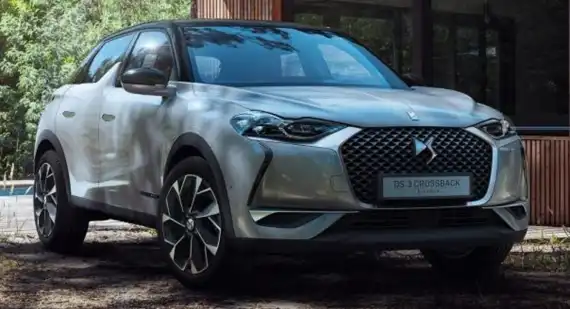
Vehicle Safety & Security
Noth the Peugeot e-2008 and DS 3 E-Tense models tested here come fitted with a vast array of safety equipment, which goes some way to explaining the impressive five-star safety rating from Euro NCAP.
However, that’s only true of these top of the range models, as lower specification cars miss out on some essential equipment.
All DS 3 models come with automatic emergency braking, lane-keeping assist, lane departure warning and traffic sign recognition, but you need to spend extra to add pedestrian and cyclist detection, road edge detection, a reversing camera and blind-spot monitoring.
Peugeot is slightly more generous with the e-2008, fitting every model with automatic emergency braking, lane-keeping assist, road edge detection and traffic sign recognition, amongst other items. A blind-spot warning system is still the preserve of the top models, though.

